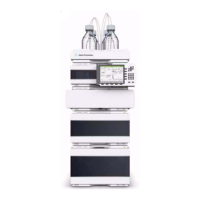74 Agilent 1200 Infinity Series DAD User Manual
4 Using the Module
Solvent Information
PEEK
PEEK (Polyether-Ether Ketones) combines excellent properties with regard to
biocompatibility, chemical resistance, mechanical and thermal stability and is
therefore the material of choice for biochemical instrumentation. It is stable in
the specified pH range, and inert to many common solvents. There is still a
number of known incompatibilities with chemicals such as chloroform,
methylene chloride, THF, DMSO, strong acids (nitric acid > 10 %, sulphuric
acid > 10 %, sulfonic acids, trichloroacetic acid), halogenes or aequous
halogene solutions, phenol and derivatives (cresols, salicylic acid etc.).
When used above room temperature, PEEK is sensitive to bases and various
organic solvents, which can cause it to swell. As normal PEEK capillaries are
very sensitive to high pressure, especially under such conditions, Agilent uses
stainless-steel cladded PEEK capillaries to keep the flow path free of steel and
to ensure pressure stability to at least 600 bar. If in doubt, consult the
available literature about the chemical compatibility of PEEK.
Titanium
Titanium is highly resistant to oxidizing acids (for example, nitric, perchloric
and hypochlorous acid) over a wide range of concentrations and temperatures.
This is due to a thin oxide layer on the surface, which is stabilized by oxidizing
compounds. Reducing acids (for example, hydrochloric, sulfuric and
phosphoric acid) can cause slight corrosion, which increases with acid
concentration and temperature. For example, the corrosion rate with 3 % HCl
(about pH 0.1) at room temperature is about 13 μm/year. At room
temperature, titanium is resistant to concentrations of about 5 % sulfuric acid
(about pH 0.3). The addition of nitric acid to hydrochloric or sulfuric acids
significantly reduces corrosion rates. Titanium is subject to corrosion in
anhydrous methanol, which can be avoided by adding a small amount of water
(about 3 %). Slight corrosion is possible with ammonia > 10 %.
Fused silica
Fused silica is inert against all common solvents and acids except hydrofluoric
acid. It is corroded by strong bases and should not be used above pH 12 at
room temperature. The corrosion of flow cell windows can negatively affect
measurement results. For a pH greater than 12, the use of flow cells with
sapphire windows is recommended.

